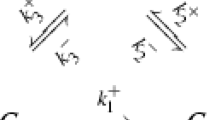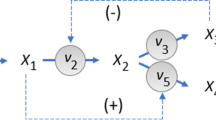Abstract
Reversibility, weak reversibility and deficiency, detailed and complex balancing are generally not “encoded” in the kinetic differential equations but they are realization properties that may imply local or even global asymptotic stability of the underlying reaction kinetic system when further conditions are also fulfilled. In this paper, efficient numerical procedures are given for finding complex balanced or detailed balanced realizations of mass action type chemical reaction networks or kinetic dynamical systems in the framework of linear programming. The procedures are illustrated on numerical examples.
Similar content being viewed by others
References
Angeli D. (2009) A tutorial on chemical network dynamics. Eur. J. Control 15: 398–406
Belov G. (2010) On linear programming approach for the calculation of chemical equilibrium in complex thermodynamic systems. J. Math. Chem. 47: 446–456
Callen H.B. (1980) Thermodynamics and an Introduction to Thermostatistics. Wiley, New York
Chellaboina V., Bhat S.P., Haddad W.M., Bernstein D.S. (2009) Modeling and analysis of mass-action kinetics—nonnegativity, realizability, reducibility, and semistability. IEEE Control Syst. Mag. 29: 60–78
Craciun G., Dickenstein A., Shiu A., Sturmfels B. (2009) Toric dynamical systems. J. Symb. Comput. 44: 1551–1565
Craciun G., Feinberg M. (2005) Multiple equilibria in complex chemical reaction networks: I. The injectivity property. SIAM J. Appl. Math. 65(5): 1526–1546
Craciun G., Feinberg M. (2006) Multiple equilibria in complex chemical reaction networks: II. The species-reaction graph. SIAM J. Appl. Math. 66(4): 1321–1338
Dantzig G.B., Thapa M.N. (1997) Linear Programming 1: Introduction. Springer-Verlag, Berlin
Dantzig G.B., Thapa M.N. (2003) Linear Programming 2: Theory and Extensions. Springer-Verlag, Berlin
A. Dickenstein, M.P. Millan, How far is complex balancing from detailed balancing? Bull. Math. Biol. (2011). doi:10.1007/s11538-010-9611-7
Donoho D.L. (2006) For most large undetermined systems of linear equations the minimal l1-norm solution is also the sparsest solution. Commun. Pure Appl. Math. 59(7): 903–934
Donoho D.L., Tanner J. (2005) Sparse nonnegative solution of underdetermined linear equations by linear programming. Proc. Natl. Acad. Sci. USA (PNAS) 102(27): 9446–9451
Tóth P., Tóth J. (1989) Mathematical Models of Chemical Reactions. Theory and Applications of Deterministic and Stochastic Models. Manchester University Press, Princeton University Press, Manchester, Princeton
Feinberg M. (1972) Complex balancing in general kinetic systems. Arch. Ration. Mech. Anal. 49: 187–194
Feinberg M. (1979) Lectures on Chemical Reaction Networks. Notes of lectures given at the Mathematics Research Center, University of Wisconsin, Madison, Wisconsin
Feinberg M. (1987) Chemical reaction network structure and the stability of complex isothermal reactors— I. The deficiency zero and deficiency one theorems. Chem. Eng. Sci. 42(10): 2229–2268
Feinberg M. (1988) Chemical reaction network structure and the stability of complex isothermal reactors— II. Multiple steady states for networks of deficiency one. Chem. Eng. Sci. 43: 1–25
Feinberg M. (1989) Necessary and sufficient conditions for detailed balancing in mass action systems of arbitrary complexity. Chem. Eng. Sci. 44: 1819–1827
Gopal V., Biegler L.T. (1997) Nonsmooth dynamic simulation with linear programming based methods. Comput. Chem. Eng. 21: 675–689
Gorban A.N., Karlin I.V., Zinovyev A.Y. (2004) Invariant grids for reaction kinetics. Physica A 33: 106–154
J. Gunawardena, Chemical reaction network theory for in-silico biologists. Technical report, Bauer Center for Genomics Research, Harvard University (2003). http://www.vcp.med.harvard.edu/papers/crnt.pdf
Hangos K.M., Szederkényi G. (2011) Mass action realizations of reaction kinetic system models on various time scales. J. Phys. Conf. Ser. 268: 012009. doi:10.1088/1742-6596/268/1/012009
V. Hárs, J. Tóth, In Qualitative Theory of Differential Equations, vol. 30, ed. by M. Farkas, L.Hatvani. On the Inverse Problem of Reaction Kinetics, Coll. Math. Soc. J. Bolyai (North-Holland, Amsterdam, 1981), pp. 363–379
Hernández-Bermejo B., Fairén V. (1995) Nonpolynomial vector fields under the Lotka-Volterra normal form. Phys. Lett. A 206: 31–37
Horn F. (1972) Necessary and sufficient conditions for complex balancing in chemical kinetics. Arch. Ration. Mech. Anal. 49: 172–186
Horn F., Jackson R. (1972) General mass action kinetics. Arch. Ration. Mech. Anal. 47: 81–116
Kauchali S., Rooney W.C., Biegler L.T., Glasser D., Hildebrandt D. (2002) Linear programming formulations for attainable region analysis. Chem. Eng. Sci. 57: 2015–2028
Klein J.A., Wu D.T., Gani R. (1992) Computer aided mixture design with specified property constraints. Comput. Chem. Eng. 16: S229–S236
Lente G. (2010) The connection between the second law of thermodynamics and the principle of microscopic reversibility. J. Math. Chem. 47: 1106–1111
Nagy I., Kovács B., Tóth J. (2009) Detailed balance in ion channels: application of Feinberg’s theorem. React. Kinet. Catal. Lett. 96: 263–267
Nicolis G., Prigogine I. (1977) Self-Organization in Nonequilibrium Systems: from Dissipative Structures to Order Through Fluctuations. Wiley, New York
Samardzija N., Greller L.D., Wassermann E. (1989) Nonlinear chemical kinetic schemes derived from mechanical and electrical dynamical systems. J. Chem. Phys. 90(4): 2296–2304
Schnell S., Chappell M.J., Evans N.D., Roussel M.R. (2006) The mechanism distinguishability problem in biochemical kinetics: the single-enzyme, single-substrate reaction as a case study. Comptes Rendus Biol. 329: 51–61
Shinar G., Feinberg M. (2010) Structural sources of robustness in biochemical reaction networks. Science 327: 1389–1391
Sontag E. (2001) Structure and stability of certain chemical networks and applications to the kinetic proofreading model of T-cell receptor signal transduction. IEEE Trans. Autom. Control 46: 1028–1047
Szederkényi G. (2009) Computing sparse and dense realizations of reaction kinetic systems. J. Math. Chem. 47: 551–568
Szederkényi G., Hangos K.M., Péni T. (2011) Maximal and minimal realizations of reaction kinetic systems: Computation and properties. MATCH Commun. Math. Comput. Chem. 65(2): 309–332
Szederkényi G., Hangos K.M., Magyar A. (2005) On the time-reparametrization of quasi-polynomial systems. Phys. Lett. A 334: 288–294
Yang J., Bruno W.J., Hlavacek W.S., Pearson J.E. (2006) On imposing detailed balance in complex reaction mechanisms. Biophys. J. 91: 1136–1141
Author information
Authors and Affiliations
Corresponding author
Rights and permissions
About this article
Cite this article
Szederkényi, G., Hangos, K.M. Finding complex balanced and detailed balanced realizations of chemical reaction networks. J Math Chem 49, 1163–1179 (2011). https://doi.org/10.1007/s10910-011-9804-9
Received:
Accepted:
Published:
Issue Date:
DOI: https://doi.org/10.1007/s10910-011-9804-9




